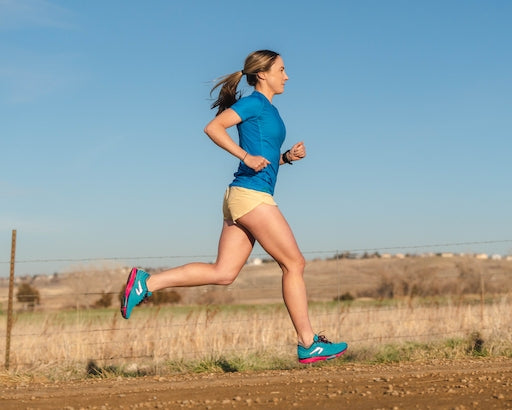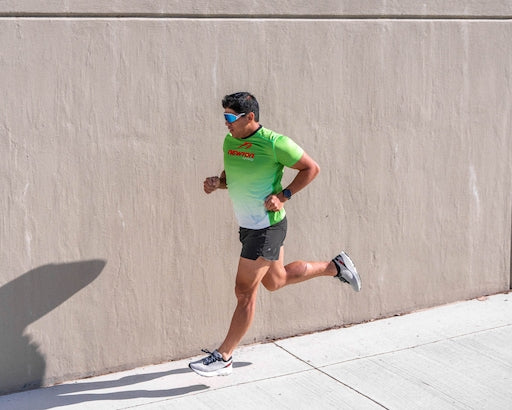A Bit About Footstrike
running form2 August 2011
Some points were brought to our attention recently in Bobby McGee’s article “The Footstrike Debate” published in USA Triathlon (Summer 2011.) the person who brought this up seems to have missed some of the salient points from the article. Newton’s Director of Education, Ian Adamson has addressed these points in both a short and long version. Read on and be enlightened!
Short
1. “Good runners heel strike for long distance”
Let’s be clear, McGee says “Good runners also tend to heel strike when they run long and slow.” This is true in affluent societies where runners overwhelmingly have adapted to running on shoes with soft midsoles and a large heel lift (12 -22 mm for regular trainers, 8 to 14 mm for racing flats.) For runners in the 5.5 Billion people on our planet who can’t afford big bulky shoes this is not true. If one examines evidence based science and don’t believe the anecdotes, this is this is fact, Lieberman et al (Nature Vol 463, 28 January 2010, 531-536.) You can certainly find examples of elite runners who have a proprioceptive heel striking phase (such as Gebrselassie), but this is not a true heel loading strike, even as McGee defines it.
2. “Transitioning from heel to midfoot is precarious and seldom achieved without injury”
(I’m glad I finally heard somebody actually say this, I’ve been struggling to convert to midfoot strike because everybody is doing it and it caused me injuries that I”m still fighting)
There is no evidence to support this. Consider barefoot running, which is probably the most extreme adaptation for a western runner who has habituated to a soft soled, heel lifted shoe. A systematic review of the literature published in Journal of the American Podiatric Medical Association [one of the most conservative when it comes to viewing footwear and running gait] (101)3: 231-246, 2011, found that “Although there is no evidence that either confirms or refutes improved performance and reduced injuries in barefoot runners, many of the claimed disadvantages to barefoot running are not supported by the literature. Nonetheless, it seems that barefoot running may be an acceptable training method for athletes and coaches who understand and can minimize the risks.”
The reality is progressive injury results from trying to adapt too rapidly. The majority of runners in our society spent years of decades adapting to big bulky western style running shoes and have become very efficient at running inefficiently. Humans have the ability to adapt to a large variety of unnatural conditions (heat, cold altitude, deep sea diving, wearing big soft high heel shoes), but this doesn’t mean the conditions are optimal for performance.
This does raise the question of what is natural. If one considers the barefoot as the natural condition for running (4.5 million years of hominid/human evolution according to the fossil record) compared to a big soft bulky shoe (40 years of modern running shoe evolution), which one is the natural condition? There is a valid argument that we need to protect our body from hard modern surfaces, which to some extent is true. But then again, they are not exactly absent in the natural world, and humans have had foot coverings for at least 5,500 years according to carbon dates artifacts. The Iceman from oAustria has straw stuffed moccasins to protect from the sharp ice and cold, good idea!
3. “Of the six US men in the ITU world championships last year, four were heel strikers.” (Wow)
Yes, wow, but not true. Do an image search and see how many true rear foot strikes you can see. They also placed 14th (Bennet – forefoot), 16th (Chrabot – forefoot), 51st (Shoemaker – forefoot), 56th (Collington – forefoot), 58th (Huerta- mid foot, possibly rear foot at times), 66th and last (Foster – wholefoot, possibly rear foot). Search for any elite runners and you will see predominantly forefoot/wholefoot/midfoot loading.
Long
Bobby McGee’s primary points in his article “The Footstrike Debate” published in USA Triathlon (Summer 2011) are not so much about where you land on your foot as your body position and loading angles.
1. McGee uses examples of athletes who successfully “heel strike”, but here’s the rub (and this later explained, see 11. below), you still need a good body position and appropriate joint angles (limb positions.) The main thing missing is a definition of “heel strike.” An often misinterpreted study by Hasewage et al (2007) showed that 38% of the top 50 runners in a half marathon (at the 15 km mark) run midfoot or forefoot, and that ground contact time decreases the faster they go. This was true of all runners, with GC time increasing for all runners as they run slower. Interestingly the definition of foot strike was when the shoe first contacts the ground. When you examine this more closely it turns out that what the geometry of the shoe has a huge effect on what touches the ground and when. Virtually every runner was wearing a heel lifted shoe (i.e. one where the heel is thicker than the forefoot), so if you control for heel thickness, the number of forefoot and midfoot strikers goes up to about 60%. Look even deeper and you find that these runners are not truly rear foot loading (see impact transient in 10. below), but are in fact running forefoot or midfoot (or whole foot) loading. McGee does a good job of describing how to do this later in his article.
2. Running on your toes is impossible. This is at least extremely difficult unless you include sprinting, in which case it’s only possible for very short distances.
3. Top (tri)athletes succeed with various foot engagement styles. Success is relative – Craig Alexander runs faster than virtually any other distance triathlete using midfoot/whole foot strike, and he’s one of the oldest professional triathletes.
4. “Transitioning from heel to midfoot is precarious and seldom achieved without injury.” Making any change too fast can lead to injury, whether that is changing your running style, introducing speed work, strength, intensity, volume, altitude, heat, cold etc. Try and climb an 8,000 m peak without acclimatization or supplemental oxygen and you will die, try and run in Death Valley in the middle of summer without heat acclimatization and you will die, try to change the loading patterns on your foot strike and you won’t die, but you’d better make sure you do it with plenty of time to strengthen the soft tissue and fine boney structures of your feet so you don;t get injured.
5. You shouldn’t try and keep your heel off the ground. Absolutely correct, in fact this is a common mistake and leading cause of injury for people adapting too fast to a midfoot/whole foot/forefoot strike.
6. It’s unlikely that foot position can lead to effective change. This is largely true, foot placement is more important, as in where in relation to the body it engages the ground.
7. Place your foot so that it is neutral or moving back relative to the ground. This is absolutely the most efficient way to engage and extremely difficult to do if you have your leg out in front of your body.
8. Allow your heel to settle and your (longitudinal) arch and Achilles tendon load like a spring. This is true, and actually engages the stretch reflex to assist with elastic recoil. Difficult in a heel striking gait, at least severely limited because the Achilles is already extended in a dorsiflexed position.
9. Consider barefoot running as the outer end of the midfoot/whole foot spectrum of runners. A systematic review of the literature published in Journal of the American Podiatric Medical Association (101)3: 231-246, 2011, found that “Although there is no evidence that either confirms or refutes improved performance and reduced injuries in barefoot runners, many of the claimed disadvantages to barefoot running are not supported by the literature. Nonetheless, it seems that barefoot running may be an acceptable training method for athletes and coaches who understand and can minimize the risks.”
10. When you review the evidence based science that examines foot position and ground impact forces, the facts are clear. Lieberman et al (Nature Vol 463, 28 January 2010, 531-536) found there is a large variation in the impact transients when comparing forefoot strike (FFS) runners to rear foot (heel) strike (RFS) runners. Impact transient is the rate and magnitude of loading on initial ground contact. It turns out that the impact transient for shod runners who RFS is three times higher than barefoot runners who FFS, and seven times higher for barefoot runners who RFS. The study found that the impact transient is largely absent for FFS runners, regardless of wearing footwear or not. Here’s an excerpt from the article: “Humans have engaged in endurance running for millions of years1, but the modern running shoe was not invented until the 1970s. For most of human evolutionary history, runners were either barefoot or wore minimal footwear such as sandals or moccasins with smaller heels and little cushioning relative to modern running shoes. We wondered how runners coped with the impact caused by the foot colliding with the ground before the invention of the modern shoe. Here we show that habitually barefoot endurance runners often land on the fore-foot (fore-foot strike) before bringing down the heel, but they sometimes land with a flat foot (mid-foot strike) or, less often, on the heel (rear-foot strike). In contrast, habitually shod runners mostly rear-foot strike, facilitated by the elevated and cushioned heel of the modern running shoe. Kinematic and kinetic analyses show that even on hard surfaces, barefoot runners who fore-foot strike generate smaller collision forces than shod rear-foot strikers. This difference results primarily from a more plantar flexed foot at landing and more ankle compliance during impact, decreasing the effective mass of the body that collides with the ground. Fore-foot- and mid-foot-strike gaits were probably more common when humans ran barefoot or in minimal shoes, and may protect the feet and lower limbs from some of the impact related injuries now experienced by a high percentage of runners.”
11. “… If your shin is leaning rearward, even slightly, you are running with the brakes on -” This is absolutely correct. McGee is describing over striding, where you land with your foot in front of your center of mass. This is the most typical heel strike, and is one of the greatest inefficiencies in running.

